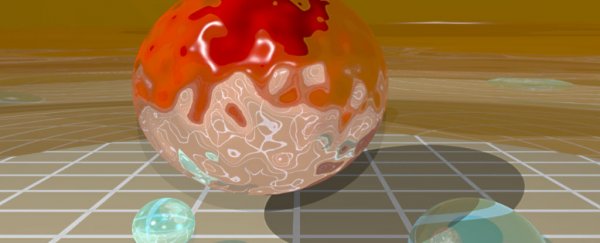Physicists have described a never-before-seen form of light, produced by binding photons (or light particles) to individual electrons.
The find not only points to easier ways to build the quantum computers of the future, it also suggests that it's possible to combine the properties of both photons and electrons in a single 'Frankenstein' particle.
"The results of this research will have a huge impact on the way we conceive light," says one of the team, Vincenzo Giannini from Imperial College London in the UK.
It's not unusual for photons to get right up close with electrons - in normal materials, photons interact with a whole bunch of them both on the surface and within their molecular structure. But Giannini and his colleagues wanted to figure out what would happen if photons could bind with just one electron.
Using a recently discovered class of materials called topological insulators, they modelled the behaviour of light as it flashed across the surface. They found that not only could the photons interact with a single electron in this material, but the result would actually combine the properties of both.
Discovered back in 2007, topological insulators are a unique type of material that won't conduct an electric current through the bulk of their structure, but will carry one along the surface, as the really handy explainer video below describes.
The UK physicists modelled a single nanoparticle - a tiny sphere less than 0.00001 millimetres in diameter - made from a topological insulator. This allowed them to simulate what would happen if a flash of light beamed across the nanoparticle and collided with its single electron.
You can see what the model looked like in the image at the top of the page, which illustrates light trapped on the surface of a topological insulator nanoparticle.
What's especially cool about the fact that the resulting particle combines properties from both the photons and the electron is that this appeared to change how the particle would move across the surface of the material.
As Joseph Dussault explains for The Christian Science Monitor:
"Light normally travels in a straight line, but when bound to a single electron, it could follow the electron's path along a material surface. And, while electrons usually stop when they encounter a poor conductor, the addition of photons would allow the coupled particle to continue moving."
Being able to control the movement of photons could have a huge impact on the race to build the world's first viable quantum computer.
Quantum processors are made of qubits, which can be a '1', '0', or both at the same time - a state known as 'superposition'. The problem with observing superposition is that physicists have to work with supercooled molecules chilled to a fraction of a degree above absolute zero, and this is expensive and difficult to set up.
But combined photon-electron could allow researchers to observe these behaviour on the visible scale and at room temperature, Giannini explained to Dussault. The catch? The team now has to take their theoretical model and demonstrate it for real in the lab, and they're recruited some experimental physicists to figure this out.
The results have been described in Nature Communications.
